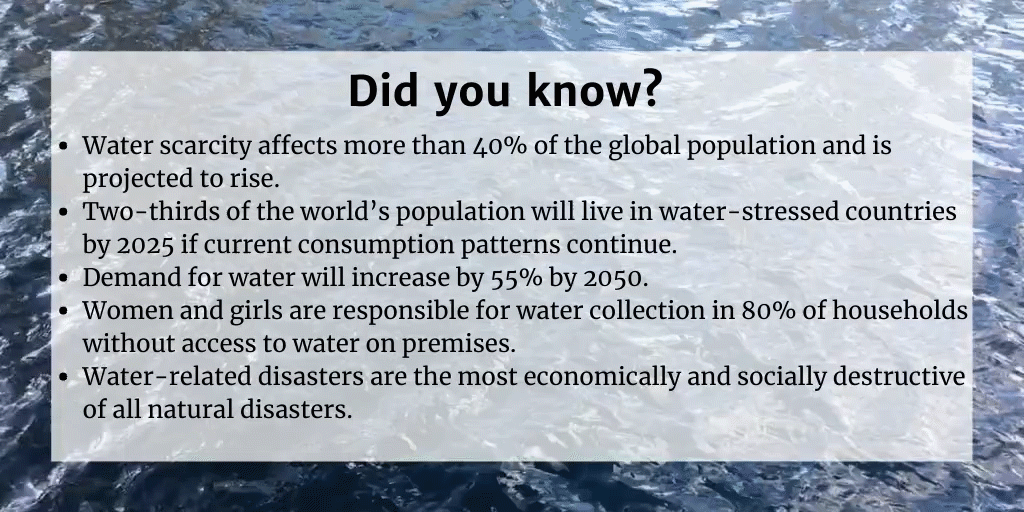What is World Water Day?
Alexandra Kowcz
Chief Scientist, Personal Care Products Council
World Water Day is celebrated every year on March 22 to help raise awareness for our need to better mitigate our use of this finite resource, which is fundamental to human well-being and only renewable when carefully managed.
The UN’s Sustainable Development Goals (SDG), launched in 2015, include a target to ensure everyone has access to safe water by 2030. Today, 3 in 10 people lack access to safe drinking water worldwide.1 Industry, government, academia, and civil society have all identified water shortages as a top global risk.
Recognizing clean, accessible water is essential for life, SDG #6 aims to address the economics and poor infrastructure that leaves millions of people, including children, without access to clean water.2 Fortunately, great progress has been made over the last decade; more than 90% of the world’s population now has access to improved sources of drinking water.3
However, as the global population grows, so will the demand for water; more people means more food production. Agriculture accounts for 70% of water withdrawals worldwide, making it by far the largest consumer of water.4 Therefore, to use water more responsibly, we must continue to identify solutions to protect our oceans and wetlands; implement new agricultural irrigation techniques; develop novel approaches to capturing and storing water; and increase the safe reuse of wastewater.
While the beauty and personal care sector is not a particularly water intensive industry, water is used in product formulations, in the manufacturing process, and by consumers when they use or remove products. Understanding the critical need for water conservation, numerous companies within the sector are learning how to do more with less and drive greater efficiency with their use of water across all aspects of a product’s lifecycle.
With ambitious public targets to reduce water consumption and improve efficiency in operations, AmorePacific, BASF, Burt’s Bees, Colgate-Palmolive, Croda, Edgewell, Givaudan, Henkel, Firmenich, IFF, KAO, L’Oréal, P&G, and Unilever have all implemented strategies that include tools to measure water use by function (cleaning, lavatories, steam heat, and cooling); closed-loop cooling systems; rainwater harvesting systems; and methods to optimize industrial processes to reduce or eliminate the need to source water from external water networks or operate with “dry” factories.
In addition to industry’s efforts to conserve water in operations, many companies are developing “Water-Smart” products, or products formulated to use less water, for instance:
- Unilever’s Love Beauty and Planet line uses fast-rinse technology in its conditioners, saving time and water.
- P&G and Henkel are promoting dry shampoo formulations, which enable consumers to go longer between washes; P&G’s waterless shampoo brands Gemz and EC30 go beyond preserving hair between washes.
- Shiseido has developed a new rinse aid technology, adapted for a foaming facial wash, that reduces water required for rinsing by 35%.
Of course, each of us can also take actions that will make a big difference including:
- Keep your showers to under 5 minutes.
- Turn off the water to brush your teeth.
- Only run the washing machine and dishwasher when you have a full load.
- Use a low flow shower head and faucet aerators.
- Install a dual flush or low flow toilet or put a conversion kit on your existing toilet.
- Don’t overwater your lawn or water during peak periods; install rain sensors on irrigation systems.
- Monitor your water usage on your water bill.
- Clean up debris along waterways, lakes, creeks, ponds, streams, or other water sources.
- Plant trees and native plants along water sources to help prevent erosion.
This year, as we celebrate World Water Day, let us focus our attention on how we can more equitably share, conserve and respect water’s essential role in the preservation of all living things.

To find out more about Goal #6 and the other Sustainable Development Goals, visit http://www.un.org/sustainabledevelopment.
___________________________________
2 https://sustainabledevelopment.un.org/sdg6
3 https://www.un.org/sustainabledevelopment/water-and-sanitation/
4 http://www.fao.org/3/a-i7959e.pdf
Resources:
https://www.worldwaterday.org/2020-home/learn/
https://www.un.org/en/actnow/resources.shtml
https://www.unwater.org/world-water-day-2020-water-and-climate-change/
https://www.un.org/en/actnow/resources.shtml
